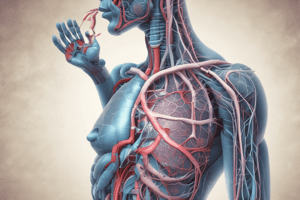Podcast
Questions and Answers
This device is capable of providing _____ body humidity.
This device is capable of providing _____ body humidity.
100%
What type of humidity does this device provide?
What type of humidity does this device provide?
100% body humidity
Which of the following characteristics describe this device? (Select all that apply)
Which of the following characteristics describe this device? (Select all that apply)
- Incapable
- Humidifier (correct)
- Heated (correct)
- Active (correct)
Which of the following are included in altered respiratory function?
Which of the following are included in altered respiratory function?
What is the primary function of antihistamines?
What is the primary function of antihistamines?
The main cause of Chronic Obstructive Pulmonary Disease (COPD) is __________.
The main cause of Chronic Obstructive Pulmonary Disease (COPD) is __________.
Corticosteroids are the first-line drug therapy for nasal steroids.
Corticosteroids are the first-line drug therapy for nasal steroids.
Which medication can lead to rebound nasal congestion if used for more than 4 to 5 days?
Which medication can lead to rebound nasal congestion if used for more than 4 to 5 days?
What are the common symptoms of asthma?
What are the common symptoms of asthma?
Match the following medications with their respective uses:
Match the following medications with their respective uses:
Patients with COPD do not require continuous oxygen therapy.
Patients with COPD do not require continuous oxygen therapy.
Study Notes
Altered Respiratory Function
- Common conditions include COPD, asthma, emphysema, tuberculosis, pneumonia, sinusitis, and upper respiratory infections (URI).
Anatomy and Physiology
- Upper respiratory system includes nasal passages, pharynx, and larynx; essential for filtering and humidifying air.
- Lower respiratory system consists of trachea, bronchi, and lungs; crucial for gas exchange.
Upper Respiratory Airway
- Filters, warms, and humidifies incoming air.
- Prevents pathogens and irritants from reaching lower airways.
- Includes structures like the nose, sinuses, and throat.
Lower Respiratory Airway
- Facilitates gas exchange; vital for oxygenation of blood.
- Air reaches alveoli where oxygen and carbon dioxide are exchanged.
- Includes bronchi, bronchioles, and alveoli.
Etiology (Causes)
- Various factors contribute, including environmental pollutants, smoking, allergens, and infections.
Medications and Mechanisms of Action
- Antihistamines: Relieve symptoms like nasal secretions and itching; do not relieve congestion.
- Decongestants: Promote vasoconstriction in nasal vessels; caution with raised blood pressure and heart rate.
- Nasal Steroids: Reduce inflammation, help sinus drainage; mild side effects like irritation.
Acute Viral Rhinitis (Common Cold)
- Symptoms may be mild but can lead to secondary infections; antibiotics may be needed.
Influenza
- Characterized by sudden onset of symptoms, including fever and fatigue.
Sinusitis
- Can develop from acute viral infections; symptoms include facial pain and pressure.
Pharyngitis Etiology
- Differentiates between bacterial (fever, lymph node enlargement) and viral (red/swollen pharynx) causes.
Nursing Care and Treatment for Pharyngitis
- Bacterial requires antibiotic therapy; viral focuses on symptom management with analgesics and hydration.
Lower Respiratory Problems
- Includes disorders like pneumonia, bronchitis, and pulmonary diseases.
Tuberculosis
- Infectious disease affecting the lungs; requires specific antibiotic treatment.
Asthma
- Chronic inflammatory disorder leading to airway obstruction, reversibility with bronchodilators.
Risk Factors for Asthma Exacerbation
- Triggers include allergens, irritants, and respiratory infections.
Chronic Obstructive Pulmonary Disease (COPD)
- The primary cause is cigarette smoking; leads to chronic respiratory symptoms and airflow limitation.
Chronic Bronchitis and Emphysema
- Chronic bronchitis characterized by a productive cough; emphysema involves enlarged air spaces and reduced breath sounds.
Complications of COPD
- Polycythemia Vera: Increased hemoglobin due to chronic hypoxia.
- Cor Pulmonale: Right-sided heart failure linked to pulmonary hypertension; serious condition requiring immediate attention.
Oxygen Therapy in COPD
- Essential for treating hypoxemia; supplemental oxygen improves survival rates.
Oxygen Delivery Devices
- Low Flow: Nasal cannula (1-6 L/min), simple face mask (6-12 L/min), customized for patient comfort and needs.
- High Flow: Nasal cannula (up to 60 L/min), offering high concentrations of oxygen effectively.
Important Notes
- Patient education is crucial for medication adherence.
- Watch for secondary infections in respiratory issues; proper management essential for recovery.
- Ongoing assessment of oxygen needs and adjustment of therapy is vital for optimal patient outcomes.
Studying That Suits You
Use AI to generate personalized quizzes and flashcards to suit your learning preferences.
Related Documents
Description
Explore the anatomy and physiology of the respiratory system, focusing on both upper and lower airways. This quiz examines common respiratory conditions and the mechanisms involved in gas exchange and filtration. Test your understanding of important concepts related to respiratory health.




